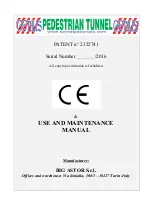
10
Maintenance
MAINTENANCE AND CLEANING
SAFETY PRECAUTIONS
• Before performing any maintenance operations take the following precautions:
•
Ensure that the machine is not working and that it has completely cooled down.
•
Ensure that the machine is disconnected from electricity supply.
•
Make certain that the electrical power cannot be accidentally reconnected. Disconnect the plug from the
socket.
•
Use individual protection devices in compliance with the directive 89/391/EEC.
•
Always use appropriate maintenance tools.
• Once maintenance and repairs are finished, reinstall all protection devices and reactivate all safety devices
before starting up the machine again.
ROUTINE MAINTENANCE FOR THE USER
• As any equipment, also our machines require a simple yet frequent and careful cleaning to ensure an
effective and regular functioning.
• It is recommended to never use abrasives, corrosives or chemical products which are not specific for food
preparation areas. Avoid by all means using water jets, unspecific tools,
•
Rough or abrasive instruments, such as steel wool or sponges or any other item which could damage the
machine surface, especially those which could jeopardize health safety.
• Using a suitable brush, perform a first removal of flour and dough remainders.
•
Remove the two protections, the balancing device and the chutes.
•
Release the dough scraper springs.
•
Pull out the dough scrapers.
•
Turn the regulation levers opening the rollers to their maximum extent.
•
Clean the machine and all the removed components using a sponge or cloth moistened with water and
detergent.
•
Carefully rinse until the detergent is completely removed.
• Dry with kitchen paper and then first go over the surfaces in contact with the dough and then the whole
machine with a soft, clean cloth soaked with a disinfectant suitable for food processing machines.
MAINTENANCE ADDRESSED TO QUALIFIED
•
Shafts and rollers must be lubricated once a year.
•
Remove protections, chutes, springs and dough scrapers.
•
Remove the back (loosen the locking screws).
•
Then remove supports.
•
Pull out rollers and joints.
•
Clean all parts thoroughly using a sponge, warm water and a food grade detergent.
• Rinse sufficiently and dry with absorbent paper.
• Lubricate both shafts and rollers’ holes with a suitable quantity of paraffin oil.
• Re-assemble and fix all previously removed components, working in the inverse order.
DEMOLITION AND DISPOSAL INFORMATION
Demolition and disposal of the machine are the sole responsibility of the owner, who must perform these tasks
in compliance with the currently safety and environmental protection rules enforced in the Country where






































